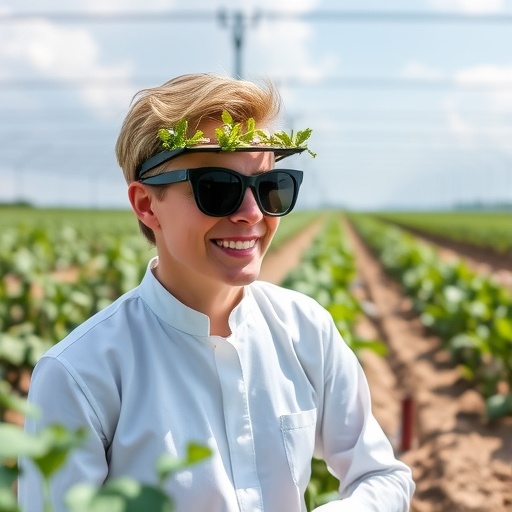In the ever-evolving field of sustainable agriculture, a groundbreaking development by researchers at the University of California, Davis promises to revolutionize greenhouse farming in hot and arid climates. The team has engineered a multilayer optical film designed to reflect heat while allowing vital light wavelengths necessary for photosynthesis to penetrate. This innovative “Cool-Cover” aims to significantly boost energy and water efficiency in greenhouse operations, addressing some of the most pressing challenges faced in regions where extreme heat threatens crop productivity.
Greenhouses have long been championed as efficient means for producing high-yield fruits and vegetables, conserving land, water, and fertilizers through controlled environments. However, in warm climates such as California’s Central Valley, the Mediterranean basin, and areas in the Middle East, greenhouse temperatures can soar to levels detrimental to plant health. Traditional cooling techniques, including mechanical ventilation and evaporative cooling, often demand substantial energy inputs and water usage, paradoxically undermining some goals of sustainable agriculture.
One common approach to mitigating heat stress in greenhouses has been the application of shade screens or coatings. While effective in reducing solar heat gain, these solutions indiscriminately block a broad spectrum of sunlight, including photosynthetically active radiation (PAR), the specific light band (400-700 nm) that plants utilize for energy during photosynthesis. Restricting PAR can curtail crop growth and diminish both yield and quality, presenting growers with a difficult tradeoff between temperature control and plant productivity.
The UC Davis team, spearheaded by postdoctoral researcher Amrit Kumar Thakur alongside Professors Saif Islam and Md Shamim Ahamed, approached this problem by exploring spectral engineering — tailoring a material’s optical properties to selectively filter specific wavelengths of light. Their multidisciplinary effort combined expertise from electrical and computer engineering with biological and agricultural engineering, yielding a thin film composed of layered nanomaterials including zinc oxide (ZnO), calcium fluoride (CaF₂), and silver. These materials are carefully stacked to exploit their unique refractive indices and reflectivity to optimize spectral selectivity.
Utilizing advanced computational simulation tools, the researchers modeled how this multilayer film interacts with solar radiation. The simulations indicated that when applied to greenhouse glass, the Cool-Cover film can reduce transmission of near-infrared radiation (NIR) — which constitutes the majority of heat-driving wavelengths — by nearly 90 percent. Impressively, it still allows around 51 percent of PAR to pass through, striking a balance that protects crops from overheating while maintaining sufficient light for robust photosynthesis.
Beyond the spectral performance, the researchers employed an established greenhouse climate model to estimate how the Cool-Cover would affect environmental conditions, water usage, and energy consumption across different climatic scenarios. Their analyses took into account hot, dry summers and milder winters, common in various agricultural zones. Results revealed significant potential reductions in irrigation water demand and cooling energy needs, a critical consideration given the often limited water availability in many farming regions.
While the film’s light-filtering properties lead to a slight reduction in crop yield, the tradeoff proves advantageous overall in water-scarce environments. By decreasing internal greenhouse temperatures without excessively compromising PAR, the technology offers a novel avenue toward sustainable intensification — maximizing output per unit of water and energy consumed. This is especially pertinent for cultivation areas experiencing high solar irradiance and chronic water shortages, such as Fresno, California.
The project’s interdisciplinary team is currently collaborating with Lawrence Berkeley National Laboratory to transition from simulation to physical production. Their ongoing efforts include fabricating prototypes of the multilayer coatings and evaluating real-world performance. They have also secured a provisional patent for the technology, signaling intent toward commercial development and widespread adoption.
This advancement sits at the intersection of agricultural engineering and materials science, illustrating how precise manipulation of optical phenomena can yield sustainable solutions to climate-related agricultural challenges. By integrating nanotechnology with agronomy, the Cool-Cover film showcases how future greenhouses might operate with heightened resilience and efficiency amidst global warming pressures.
As global populations rise and arable land remains finite, innovations like these address the urgent need to decouple agricultural productivity from resource-intensive inputs. Efficient greenhouse designs that reduce energy and water footprints without sacrificing crop quality are fundamental to achieving food security in a changing world. Technologies that enable selective spectral filtering offer a promising pathway to tailor microclimates for diverse crops and environments.
In summary, the UC Davis research presents a compelling case for spectrally engineered films as a transformative agricultural technology. With nearly 90 percent rejection of heat-inducing infrared radiation and over half of the critical photosynthetic light transmitted, the Cool-Cover film could set new standards in greenhouse energy and water stewardship. Its development underscores the importance of convergent science bridging engineering, plant biology, and environmental modeling to create innovative solutions for sustainable agriculture’s future.
Subject of Research: Not applicable
Article Title: Spectrally Engineered Greenhouse Cool Cover for Energy and Water Efficiency in Diverse Climates
News Publication Date: 27-Aug-2025
Web References: https://advanced.onlinelibrary.wiley.com/doi/10.1002/aesr.202500217
References: 10.1002/aesr.202500217
Keywords: Agricultural engineering, Sustainable agriculture, Materials engineering




